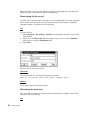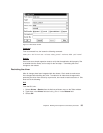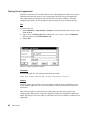
Using a configured process
The scenarios in this chapter and the preceding chapter illustrate one release with no
process management enabled and another release with full process management
enabled. However, administrators can define a release that requires users to work with
some intermediate level of process management. That is, the administrator can remove
some of the subprocesses from the full-tracking scenario.
For example, the administrator might want to eliminate the driver subprocess. If the
driver subprocess is eliminated, the user cannot create driver members to associate the
changes in a work area with a driver. Likewise, users cannot commit drivers to integrate
several work areas with the release. Instead, users integrate the changes for each work
area by integrating the work area with the release.
To demonstrate how this works, assume that Carol and Alex are trying to fix the robot’s
dislike of striped wallpaper using a release without the driver subprocess enabled.
Initially, the scenario is not affected by the absence of the driver subprocess. The defect
is opened, and a work area is created. Alex, after receiving notice that he needs to
solve the problem, goes through the process of checking out the faulty part, making
fixes, checking the fixes into the work area, and rebuilding. He can still freeze the work
area whenever he wants to save its current content.
The difference occurs when Alex is ready to integrate his changes with the release.
When the driver subprocess is not enabled, Alex issues the following command:
teamc workarea -integrate 456 -release robot_control
This command moves the part versions associated with work area 456 into the release
so they are visible to other developers. However, if collision records are created,
TeamConnection flags the concurrent changes and stops the integration until the
changes are reconciled and the corresponding collision records are completed.
Retrieving a past version of a part
Versioning is an insurance policy for the developer. By freezing the work area, the
developer knows that the parts currently visible in the work area will be retained in their
current form.
For this example, assume that Alex just updated the optics.c module to add support for
a new zoom lens. Alex did a considerable amount of work on this task, and it required a
dozen check-out, check-in, and build cycles before he finished. Alex’s work area now
contains the following:
brain.c leg.c
brain.obj leg.obj
brain.exe (from Alex's build 12) foot.c
Chapter 6. Working with component and release processes 97


















